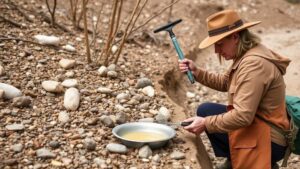Recovering Gold and Silver From Rock Shelves in Shallow Streams
Recovering Gold and Silver From Rock Shelves in Shallow Streams
Gold and silver have fascinated humans for centuries, not only due to their monetary value but also for their physical properties and aesthetic appeal. One of the less commonly known methods of recovering these precious metals involves searching for them in the rock shelves of shallow streams. This article delves into the process, techniques, and considerations involved in mining these precious resources from such natural settings.
Understanding Rock Shelves in Streams
Rock shelves are geological formations where bedrock is exposed at the surface, often creating a series of steps or ledges along the waterway. e natural structures can be ideal locations for mineral deposits, particularly in areas known for historic gold and silver mining activity. Erosion processes can transport these metals from upstream sources and deposit them in the gravel and rock shelves of shallow streams.
Assessing Viability of Sites
Before undertaking extraction, it is critical to assess the viability of specific stream locations. Here are key factors to consider:
- Geological Surveys: Conduct localized geological surveys to identify past mining activity and known mineral deposits. Geological maps and reports can provide insights into the likelihood of finding gold and silver.
- Water Flow: Continuous water flow can help dislodge and carry minerals downstream. Locations with higher water flow typically yield better results.
- Proximity to Lode Sources: Sites situated near recognizable lode deposits are prime targets for recovery efforts, as they have a higher chance of receiving mineral washouts.
Techniques for Mineral Recovery
Once a suitable site has been identified, various methods can be employed to recover gold and silver from the rock shelves:
- Panning: A classic method of gold recovery that is particularly effective in shallow streams. The user fills a pan with sediment and uses water to wash away lighter materials, leaving behind heavier minerals.
- Sluicing: This method utilizes a sluice box to process larger quantities of sediment. As water flows through the sluice, heavier metals get trapped behind riffles while lighter materials wash away.
- Metal Detecting: Utilizing metal detectors specifically designed for gold can increase the likelihood of finding concealed deposits in and around rock shelves.
Environmental Considerations
Responsible mining practices are essential. Over-extraction can lead to significant environmental degradation, including habitat destruction and sedimentation issues. It is crucial to comply with local regulations and employ sustainable practices:
- Permits: Ensure all necessary permits are obtained to conduct mining operations legally and responsibly.
- Restoration: After extraction, rehabilitating disturbed areas is vital to promote ecological balance and support local wildlife.
Real-World Applications: Case Studies
Numerous regions have successfully implemented techniques for recovering gold and silver from shallow streams:
- The Yuba River, California: Known for its rich history in gold mining, modern-day gold prospectors utilize panning and sluicing methods to recover valuable metals from its rock shelves.
- The Murray River, Australia: This river offers considerable deposits of alluvial gold that can be recovered using shallow stream recovery techniques. local economy benefits significantly from small-scale gold mining operations.
Actionable Takeaways
For those considering engaging in gold and silver recovery from rock shelves in shallow streams, the following steps are recommended:
- Conduct thorough research on local geology and historical mining sites.
- Obtain necessary permits to ensure environmentally responsible practices.
- Employ proven extraction techniques suited for the specific environment.
- Commit to sustainable practices, ensuring the protection of the ecosystem.
Recovering gold and silver from rock shelves in shallow streams can be both a rewarding and educational venture. By understanding the geological and environmental principles and employing responsible mining techniques, enthusiasts can engage in a sustainable practice that also respects nature.


